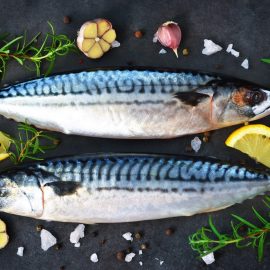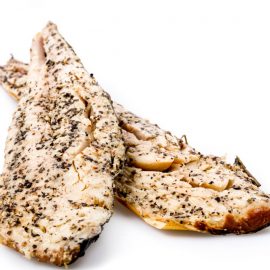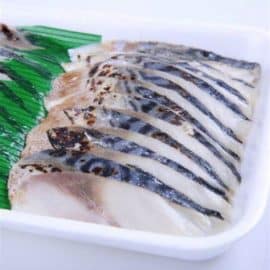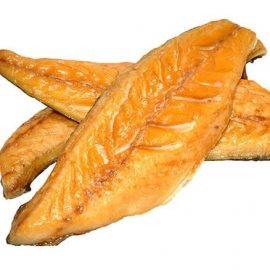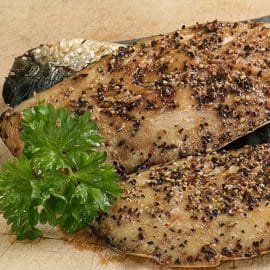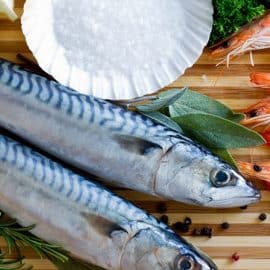
Introduction to Mackerel
Mackerel is a family of ray-finned fish found in the world’s temperate and tropical seas and belongs to the Scombridae family, the true mackerels. It has been consumed worldwide since ancient times and is one of the most commercially harvested fish in international waters. A sustainable source and rich, flavorful flesh make this species famous.
Description
Mackerels have slim bodies and rounded heads, typically between 40-70 cm in length and 0.7-1.3 kg in weight. They feature an overall silvery-white colouration, with a blue-green upper side and silver on the silvery-green underside.
These fish are dotted with many small spots that lighten upon being freshly caught. These creatures’ bodies are covered in small Ctenoid scales with a lateral ridge and huge yellow eyes with visible irises.
Physical Characteristics
Mackerels have long, narrow heads, a mouth full of sharp teeth, two forward-facing eyes, a single dorsal fin, vertical stripes and two pectoral fins. Their tiny mouths have sensitive teeth and small eyes.
Mackerel stripes appear so distinctively that they are used to describe other creatures, for example, mackerel tabby cats. Once the fish dies, the patterns fade.
Amazingly, they can reach up to 50 km/h when swimming, making them one of the fastest fish in the sea.
Mackerel have the unique ability to give off light through a process called bioluminescence. This light is used for communication, warnings, and as a lure for prey.
Habitat and Feeding
Atlantic mackerel, king mackerel and other species generally live in shallow water near shorelines and reefs, ranging from shallow lagoons to deep oceanic waters. They can be found in temperate and tropical waters, ranging from the Atlantic to the Mediterranean and Black Seas. They swim in large schools and live near shorelines and reefs.
Mackerel are voracious predators and mainly consume small fish and crustaceans. Their diet also consists of jellyfish, squid and plankton. They actively hunt their prey using their vision and lateral line system to detect potential food and quickly pursue and capture their targets.
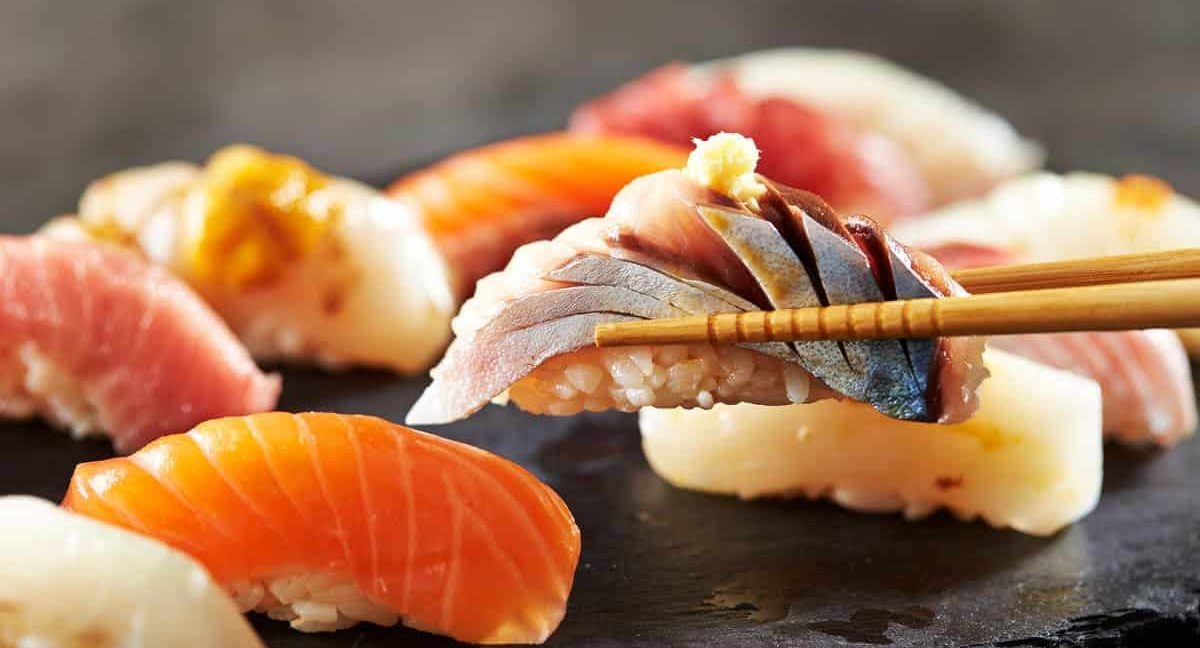
Mackerel Fisheries
Mackerel fisheries are an established and highly profitable global industry, with a wide array of conservation, sustainability and management measures in place to ensure the health and long-term sustainability of this fish, including other species. Organisations such as the International Council for the Exploration of the Sea (ICES), the International Commission for the Conservation of Atlantic Tunas (ICCAT), and the North East Atlantic Fisheries Commission (NEAFC) are actively involved in the management and conservation of mackerel stocks.
Population and Conservation
Organisations such as the Marine Stewardship Council (MSC), Global Trust for Responsible Fisheries (GTRF) and the World Wildlife Fund (WWF) are all engaged in promoting and advancing responsible and sustainable fisheries for Mackerel. They promote reliable catch methods, transparent management practices, and research initiatives to efficiently conserve and manage Mackerel stocks.
Conservation and management initiatives are also in place in different parts of the world. For example, catch limits, and minimum size restrictions have been established by the Commission for the Conservation of Antarctic Living Marine Resources (CCAMLR) to protect Southern Ocean Mackerel stocks. The General Fisheries Commission for the Mediterranean (GFCM) has also implemented regulations that reduce bycatch of other fish species and protect juvenile mackerels in the Mediterranean Sea.
The International Seafood Sustainability Foundation (ISSF) is a global fisheries management organisation that works with governments and other stakeholders to develop strategies for responsible fisheries management and the long-term conservation of the Mackerel species. Through their program, ISSF puts in place measures to reduce by-catches, prevent illegal catches, and promote data-driven fishery assessments and advisories to ensure the sustainability of the Mackerel fisheries.
Overall, Mackerel fisheries are managed responsibly and regulated to ensure their sustainability both now and in the future. The global Mackerel industry can thrive for generations through research, conservation initiatives, and data-driven management.
Distribution of Mackerel Stocks
Mackerel has a broad, horizontal distribution throughout their range and migrate seasonally with changing temperatures. They are found at depths of up to 1,600 meters and in nearshore, offshore and deepwater areas. Mackerel tend to congregate in large schools near the surface or cooler, deeper parts of the ocean.
Various oceans and seas are home to Mackerel, including the Atlantic, Pacific and Black seas. Mackerel are of significant economic importance, as they are highly sought after as a food source and are integral to commercial fishing operations. They are also popular with sports fishermen due to their speed and difficulty catching them.
Conservation Status
Mackerel is a relatively common fish, compared to other fish such as salmon, and can easily be found in most areas. It is also a sustainable fish option, making it a smart choice for those looking to include healthy seafood in their diet without harming the environment.
Sustainable Fishing Practices
Due to its abundance and taste, Mackerel has become a precious commercial species. It is an affordable and versatile source of protein, used in many dishes worldwide.
Mackerel fishing has been an invaluable source of food for centuries. The fish has a high market value for its consumption, with sustainable wild-caught and aquaculture options available. It is also a popular sport fishing species.
Mackerel’s Diet
As carnivores, mackerels typically feed on small fish, crustaceans, molluscs, squid, and zoobenthos. Studies have identified that mackerels live in the eastern Atlantic’s temperate waters and feed primarily on tiny pelagic fishes. In contrast, those found in Western Atlantic waters mainly feed on zooplankton.
Small crustaceans and molluscs such as crabs, squid, and octopuses often make up a portion of the Mackerel’s diet. A broader omnivorous lifestyle exists in Mackerel, with eggs of other fishes and small invertebrates making up a portion of the mackerel diet. Depending upon the availability of food sources, mackerels change the type of prey they eat according to their age, size, and season.

Generally, younger mackerels feed mainly on larvae and planktonic organisms, while adults feed primarily on schooling fishes and smaller invertebrates. In some regions, mackerel meal plans consist primarily of jellyfish. Therefore, mackerels can take advantage of seasonal prey availability and migrate towards areas with plenty of food abundance.
Reproduction
Mackerels spawn twice a year, typically around the spring and autumn. They generally spawn in the deeper waters at night, with the eggs, which are transparent and spherical, then floating to the surface and being carried away by the currents.
Mackerel form large spawning aggregations during the spawning season, where hundreds of individuals gather. After spawning, the adults move away from the spawning site and head back to the ocean to feed. Spawning takes place at night and involves male mackerels releasing sperm to fertilise the female Mackerel’s eggs. The adult mackerel then release the eggs into the water, where they hatch into larvae after 12-24 hours.
Newly hatched Mackerel fry measure only a few millimetres in length and develop quickly by feeding on plankton and small fish.
Life Span and Life Cycle
Mackerel typically live up to 9 years in the wild and can survive up to 12 years in some cases. Mackerel reach sexual maturity during their second or third year of life, at which point they begin spawning in the spring or early summer. After spawning, they return to the ocean and feed on smaller fish and other marine organisms. Mackerel reach their maximum size after 3-4 years of life.
Classification
The scientific classification of the Mackerel family is as follows:
Kingdom: Animalia
Phylum: Chordata
Class: Actinopterygii
Order: Perciformes
Family: Scombridae
Genus: Scomber and Trachurus
Etymology
Mackerels belong to the family Scombridae and the genus Scomber. The word “mackerel” is derived from the Latin words macula and cellus, which translate as spotted fish.
While some believe that the word Mackerel comes from the Old English macerel, derived from the Latin macare, meaning to shine. The people then adapted the term to Mackerel in the 15th century.
Culinary Uses
Mackerel is highly popular in many global cuisines due to its distinct flavour. It comes raw, as sushi or sashimi, grilled or smoked and is enjoyed in various dishes.
Significance
Mackerel are of significant commercial and recreational value, harvested for human consumption and provide excellent game fishing opportunities along coastlines worldwide. Additionally, mackerel are important prey species for larger predators such as tuna, marlin, and sailfish.
Uses
Due to their wide range and identifiable characteristics, Mackerel has become a popular species for commercial and recreational fisheries. Its importance in consumption and as a source of income should be noticed.
Popularity and Availability
Mackerel is a popular source of food around the world, particularly in Europe and Japan. It is eaten raw or cooked and is a popular ingredient in many Asian and Mediterranean cuisines. It can also be preserved and canned for long-term storage. On top of being a nutrient-rich source of protein, Mackerel is also a good source of healthy omega-3 fatty acids.
Mackerel is also an abundant food source for larger marine animals such as sea lions, seals, dolphins, and whales. It is also a target species for anglers due to its fighting prowess and attractive patterned backs. As a highly valued species in the global fish market, the commercial and recreational fisheries targeting this species demonstrate the importance of Mackerel and their role in the marine ecosystem.
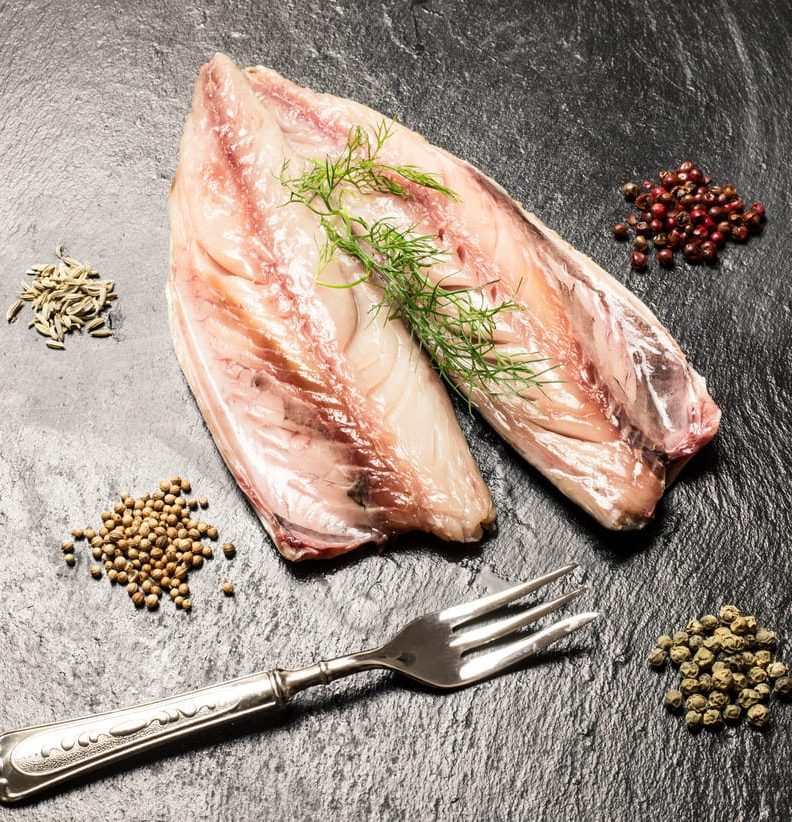
Nutritional Values
Mackerel is a rich source of omega-3 fatty acids, providing more than most fish in a 3 oz. serving. It is high in protein, offering 10 grams per serving and Vitamin A, B vitamins, Niacin, Iron, Magnesium, Calcium, and Selenium. Mackerel is also a healthy source of vitamin D and selenium. It is a relatively low-mercury fish, making it a safer option for those concerned about mercury levels in their diets. Compared to other fish, Mackerel contains higher amounts of polyunsaturated fatty acids, believed to reduce cholesterol levels and promote heart health. Mackerel has around 150 calories per 3-ounce serving, with fat content at approximately 10-15 grams per serving. It is also higher in sodium than some other fish. Low in fat and rich in beneficial omega-3 fatty acids, Mackerel has incredible nutritional value compared to other fish.
Health Benefits
Mackerel consumption has contributed to numerous health benefits. Eating Mackerel may help reduce the risks of heart disease and stroke and promote cognitive health. It may also be beneficial for reducing inflammation and improving symptoms of rheumatoid arthritis.
Versatility
Mackerel is a highly versatile fish characterised by its naturally buttery, flaky texture, making it a suitable candidate for various cooking methods. Choosing the correct vegetables to pair with them to reach their full potential and create a delicious meal is essential. Not only do these vegetables add to the flavour palette, but they can also offer delightful differences in texture, creating a dynamic plate of food.
Selecting and Eating Mackerel
It is wise to select Mackerel carefully when in the store, paying attention to the freshness of the fish. The ideal Mackerel will be bright and have its skin and scales intact. To ensure a pleasant eating experience, Mackerel should be scaled and gutted before cooking and sprinkled with salt and pepper for a more intense flavour.
Cooking Mackerel with ingredients such as garlic, onions, and herbs can further enhance its unique taste. Additionally, Mackerel’s fat lends a distinct flavour to dishes, providing a mild yet flavorful taste that adds depth.
Taste and Texture
Mackerel is a versatile fish that pairs deliciously with flavorful side dishes to bring out its subtle flavour. Popular side dishes for Mackerel include potatoes, roasted vegetables and root vegetables, salads, rice dishes, and sauces like tzatziki and skordalia. Roasted potatoes, carrots, parsnips, and turnips are a delicious accompaniment to Mackerel as they help balance out its flavour.
For a heartier dish, mackerel pairs well with flavorful rice dishes, such as jambalaya or sushi. Salads with complementary flavours such as spinach, kale, arugula, and marinaded vegetables or salads are delicious for bringing out the taste of Mackerel. For a tasty flavour combination, Mackerel can be breaded and cooked with tartar sauce or served over pasta with onions, garlic, and peppers.
Mackerel is an excellent choice for any meal and is available in many ways to create an enjoyable culinary experience. From its mild, mildly salty taste to its oily texture and light, flaky consistency, Mackerel is a delicious and nutritious fish. It pairs perfectly with various side dishes to bring out its unique flavour.
Preparation
Mackerel can be prepared in various ways, depending on regional cuisine. Some of Japan’s most popular dishes featuring Mackerel include sashimi, sushi, hand rolls, and temaki. Other standard preparation techniques include tataki (briefly seared Mackerel), grilled whole fish, boiled with soy sauce and mirin, poached in miso, simmered in sake, and teriyaki style.
In Korean cuisine, Mackerel is most commonly served as jeon (fried pancakes) but can also be eaten raw in jaecheop or braised with vegetables in a soupy dish known as a hoe. In the Caribbean Islands, Mackerel is often fried with herbs and spices and sometimes served with tomato sauce. It is also popular in fish cakes, patties, salads, pasta dishes, and curries.
In the United States and the United Kingdom, Mackerel is usually served grilled or broiled, as steaks or fillets, and with a variety of sauces, such as tomato-based sauces and rich cream sauces. In South India, Mackerel is known as ‘Meen Kari’ and is commonly cooked in a spicy sauce with mustard, dried red chillies, tamarind, and curry leaves. In Portugal,
The traditional way to prepare mackerel is with garlic and bay leaves. In the Netherlands, Mackerel is often served as gefileerde makreel, or mackerel fillets cured in vinegar and rolled in breadcrumbs. In France, Mackerel usually comes as sardines en escabeche, prepared by marinating in vinegar.
In India, Mackerel is popularly served as a fish fry. Mackerel sushi is another popular dish in many Japanese restaurants. In Norway, Mackerel is traditionally prepared as kofta curry, a dish of ground-up fish cooked in a spicy sauce. And in Sri Lanka, Mackerel is a popular dish known as ‘Ambulthiyal’, cooked with a blend of spicy ingredients, including chilli, mustard, onions, and tomatoes.
Cooking Techniques
The most effective way to achieve optimal flavour and nutrition from Mackerel is to cook it with fresh fish. It can be served hot or cold and cooked in large and small amounts. Mackerel is a highly versatile fish you can prepare in traditional or modern recipes. It is ideal for both solo cooking and family meals.
Mackerel is a versatile, easy-to-prepare fish with a variety of cooking techniques. Popular options include grilling, baking, frying, and steaming. Additionally, it can be canned, smoked, or salted as a convenient food option.
In conclusion, Mackerel is a flavorful and nutritious fish for dinner. With its strong taste, multiple textures, and various cooking methods, anyone can enjoy this excellent addition to their kitchen.
Serving
Mackerel is best served hot with a crunchy side, such as roasted vegetables or a salad. Mackerel can last for up to two days when stored in the refrigerator. It is low in calories and high in omega-3 fatty acids, which may provide various health benefits, such as lower cholesterol and improved cardiovascular health.
Side Dishes
Mackerel pairs well with traditional sides, such as roasted potatoes, slow-cooked vegetables, steamed broccoli, and boiled greens like kale or spinach. Other accompaniments such as fruity pilafs, pickled vegetables, or a sweet relish add another layer of flavour. For extra zest, try pairing Mackerel with a citrusy slaw or salsa fresca. The delicate flavour of Mackerel also pairs beautifully with classic sauces, such as tartar sauce, remoulade, aioli, or a light sauce.
For a more contemporary take, Asian-style preparations like teriyaki and grilled Mackerel often complement with steamed white rice, pickled ginger, or a light sauce. You can also serve mackerel with salads with different dressings, such as balsamic vinaigrette, olive oil dressing, or lemon juice. To further bring out the subtle flavours of Mackerel, a light soup, such as tomato-based or fish chowder, can be served as an appetiser or side.
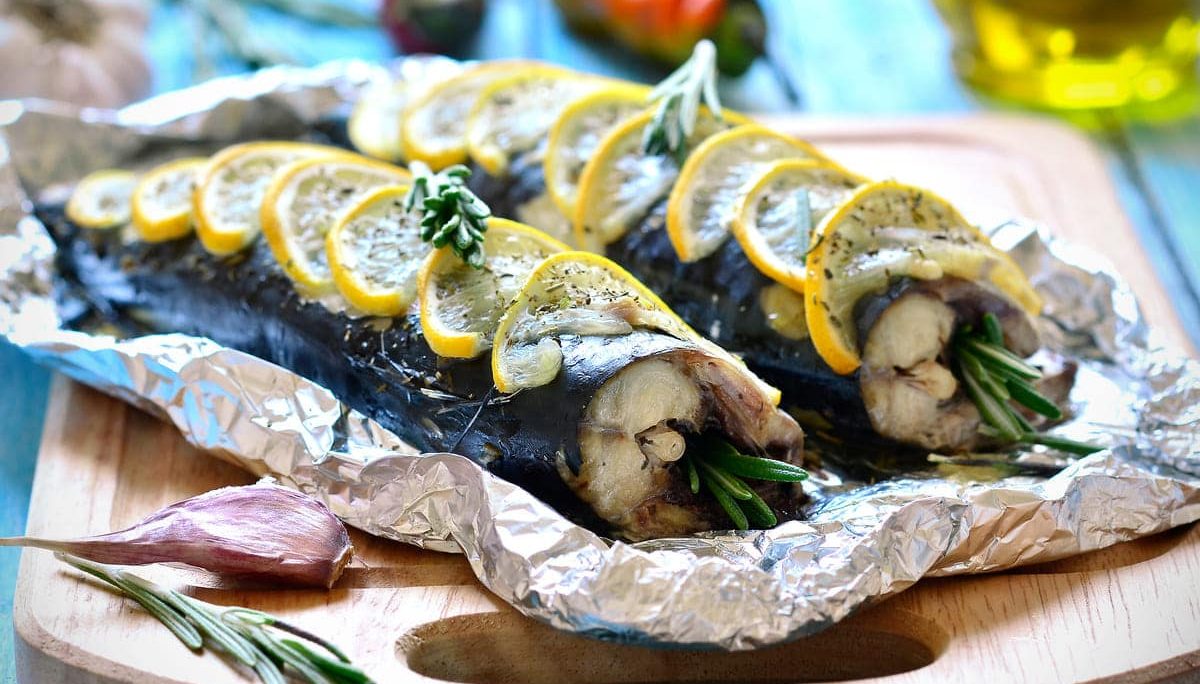
Suitable Sauces & Spices
Mackerel and herbs such as oregano, thyme, marjoram, and basil are popular choices for seasoning. Seasonings such as hot pepper and chilli powder help to kick the fish’s flavour.
Flavourings such as mustard, garlic, and honey are also applied to give the Mackerel a savoury flavour. Additionally, various store-bought or homemade sauces are served to top the fish. Famous sauces include tartar sauce, cocktail sauce, soy sauce and ginger-garlic sauce.
A zesty vinaigrette, citrus fruits, or a tangy sauce are especially good with mackerel. Balsamic vinegar, sweet chilli sauce, teriyaki sauce, and yoghurt-based marinades are also ideal for marinating Mackerel before cooking.
Popular Recipes
Due to its strong flavour and versatility, you can use Mackerel in different recipes. The most popular dishes are Grilled Mackerel with lemon and herbs, Mackerel with Romesco sauce, Mackerel stuffed with tomato and capers, Braised Mackerel with greens, Baked Mackerel with garlic and herbs, Mackerel with sesame and ginger, Mackerel with chilli and soy, Curried Mackerel, Mackerel with fennel, Mackerel with tomatoes and olives, Mackerel with miso glaze, and Mackerel with tomato and thyme.
The fish is hand-rubbed with herbs, spices, vinegar, butter, bread crumbs, onions, garlic, and citrus juice when making mackerel recipes. Roasting, baking, grilling, or pan-frying the fish are standard cooking methods. Seasonings and accompaniments such as cooked vegetables, steamed rice, and potatoes are also usually included.
Different countries have different fish recipes. For instance, there is the classic Danish Pickled Mackerel, Spanish Mackerel Escabeche, Japanese Fried Mackerel, French Grilled Mackerel, Indonesian Balado Mackerel, and English Fried Mackerel in Breadcrumbs.
Types of Cuisine
Mackerel can be seen in various global cuisines, each having its unique take on the fish. In Japan, it is often served as part of a traditional meal, while it is becoming increasingly popular for sushi and sashimi.
The Mediterranean uses Mackerel in salads and appetisers, while India and South Asia typically fry it and pair it with a spicy curry. Portugal pickles or cooks Mackerel in a stew, while Korea serves it as a side dish with steamed rice.
West African cuisine takes advantage of grilling and smoking methods, while in Europe, mackerel is often smoked and used in salads. Lastly, Mackerel is a typical main dish in Brazil.
Cultural Symbol
Mackerel is more than just nutritious; it symbolises luck and positive wishes in many cultures. It is an abundant, affordable, and flavorful fish, making it a favourite among many worldwide.
Conclusion
Mackerel is a popular choice among seafood lovers and health-conscious eaters alike. With its bold flavour and tender texture, you can use it in various cooking techniques to create a wide array of dishes. Its flavour profile is unique, so it best suits those who appreciate its distinctive taste.

